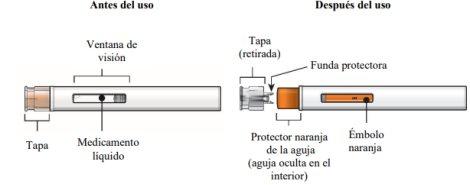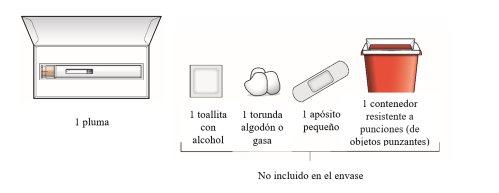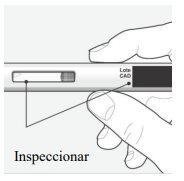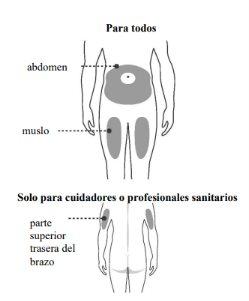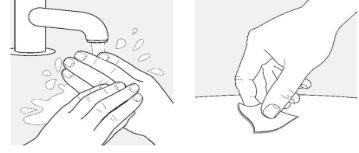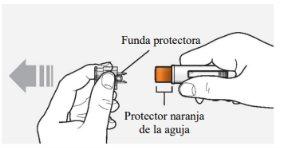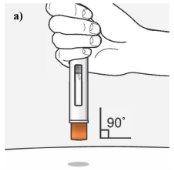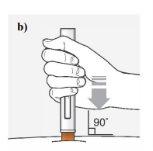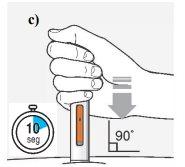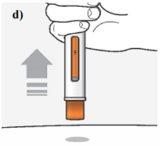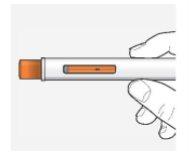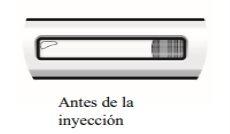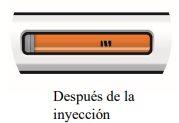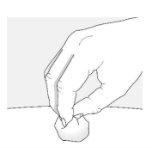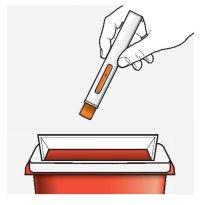
WAINZUA 45 mg INJECTABLE SOLUTION IN PRE-FILLED PEN
Ask a doctor about a prescription for WAINZUA 45 mg INJECTABLE SOLUTION IN PRE-FILLED PEN

How to use WAINZUA 45 mg INJECTABLE SOLUTION IN PRE-FILLED PEN
Introduction
Package Leaflet: Information for the Patient
Wainzua 45mg solution for injection in pre-filled pen
eplontersen
This medicine is subject to additional monitoring, which will allow for quicker identification of new safety information. You can help by reporting any side effects you may get. The last section of the leaflet includes information on how to report side effects.
Read all of this leaflet carefully before you start using this medicine because it contains important information for you.
- Keep this leaflet, you may need to read it again.
- If you have any further questions, ask your doctor, pharmacist, or nurse.
- This medicine has been prescribed for you only. Do not pass it on to others. It may harm them, even if their signs of illness are the same as yours.
- If you get any side effects, talk to your doctor, pharmacist, or nurse. This includes any possible side effects not listed in this leaflet. See section 4.
Contents of the pack
- What is Wainzua and what is it used for
- What you need to know before you use Wainzua
- How to use Wainzua
- Possible side effects
- Storage of Wainzua
- Contents of the pack and other information
1. What is Wainzua and what is it used for
The active substance of Wainzua, eplontersen, is a type of medicine called an antisense oligonucleotide.
Wainzua is used to treat adults with nerve damage throughout the body (polyneuropathy) caused by hereditary transthyretin-mediated amyloidosis (ATTRv).
In people with ATTRv, the transthyretin (TTR) protein is defective and breaks down easily. This causes it to clump together and form deposits called amyloid deposits, which can build up around or inside nerves and other parts of the body and prevent them from working normally.
Wainzua works by reducing the amount of TTR protein produced by the liver. As a result, there is less TTR protein in the blood to form amyloid deposits, and this can help reduce the symptoms of the disease.
2. What you need to know before you use Wainzua
Do not use Wainzua:
- if you are allergic to eplontersen or any of the other ingredients of this medicine (listed in section 6).
Warnings and precautions
You will need vitamin A supplements during treatment with Wainzua.This medicine reduces the amount of vitamin A in your blood. Your doctor will check your vitamin A levels before treatment.
- Your doctor will ask you to take a daily oral vitamin A supplementduring treatment.
Signs of low vitamin A levels can include poor vision, especially at night, dry eyes, blurred or cloudy vision, or eye inflammation (redness, pain, excess tears or other discharges, or a feeling of something in the eye).
- Tell your doctor if you notice vision problemsor any other eye problems while using Wainzua. If necessary, your doctor will refer you to an eye specialist for a check-up.
You must confirm that you are not pregnantbefore starting treatment with Wainzua. Both high and low levels of vitamin A can harm the development of the fetus. Women of childbearing age must use effective contraceptive methodsduring treatment with Wainzua (see section "Pregnancy and breastfeeding" later in this leaflet).
- Vitamin A levels may remain low for more than 15 weeks after the last dose of Wainzua.
- Tell your doctor if you plan to become pregnant.Your doctor will advise you to stop taking Wainzua and the vitamin A supplement. Your doctor will also make sure that your vitamin A levels have returned to normal before you try to become pregnant.
- Tell your doctor if you become pregnant unintentionally during treatment.Your doctor will advise you to stop taking Wainzua. In the first 3 months of your pregnancy, your doctor may advise you to stop taking the vitamin A supplement. During the last 6 months of your pregnancy, your doctor may advise you to resume the vitamin A supplement if your vitamin A levels have not returned to normal, due to a higher risk of deficiency during the last 3 months of pregnancy.
Children and adolescents
Wainzua must not be used in children and adolescents under 18 years of age. Its safety and efficacy in this population have not been established.
Other medicines and Wainzua
Tell your doctor or pharmacist if you are using, have recently used, or might use any other medicines.
Pregnancy and breastfeeding
If you are pregnant or breastfeeding, think you may be pregnant, or are planning to have a baby, ask your doctor or pharmacist for advice before using this medicine.
Women of childbearing age
Wainzua will reduce the level of vitamin A in your blood, and vitamin A is important for the normal development of the fetus (see section "Warnings and precautions" earlier in this leaflet).
- You must use effective contraceptive methodsduring treatment with Wainzua if you are a woman who can become pregnant.
- Talk to your doctor or nurse about suitable contraceptive methods.
- You must confirm that you are not pregnant before starting treatment with Wainzua.
- Tell your doctorif you plan to become pregnant or if you become pregnant during treatment. Your doctor will advise you to stop taking Wainzua.
Pregnancy
Do not use Wainzua if you are pregnant.
Breastfeeding
It is not known whether the active substance of Wainzua can pass into breast milk. The risk to the breastfed child cannot be excluded. If you are breastfeeding or plan to breastfeed, tell your doctor before starting treatment. Your doctor may advise you to stop taking Wainzua.
Driving and using machines
Wainzua is unlikely to affect your ability to drive or use machines. Your doctor will tell you whether your condition allows you to drive and use machines safely.
Wainzua contains sodium
This medicine contains less than 1 mmol of sodium (23 mg) per 0.8 ml dose, which is essentially "sodium-free".
3. How to use Wainzua
Follow exactly the administration instructions for this medicine given by your doctor, pharmacist, or nurse. If you are unsure, ask your doctor or pharmacist again.
The recommended dose is one 45 mg injection per month.
Wainzua is given by injection under the skin (subcutaneously). The injection can be given in the stomach area (abdomen) or the top of the thigh. If given by a caregiver or healthcare professional, Wainzua can also be injected into the back of the upper arm. Do not inject the medicine into skin that is bruised, tender, red, or hard, or into scars or damaged skin. Avoid the area around the navel.
You and your doctor or nurse will decide if Wainzua should be injected by you, your caregiver, or a healthcare professional. You or your caregiver will receive training on how to prepare and inject this medicine correctly. Read the "Instructions for use" carefully before using the pre-filled pen (provided in a separate leaflet).
Your doctor will tell you how long you should receive Wainzua. Do not stop treatment unless your doctor tells you to.
If you use more Wainzua than you should
If you inject too much, seek medical attention immediately or go to the emergency department of a hospital. Do this even if you do not have any symptoms. Take the packaging or the pen with you.
If you forget to use Wainzua
If you miss a dose of Wainzua, give the next dose as soon as possible and continue with the monthly injections from then on. Do not give a double dose.
If you have any other questions about the use of this medicine, ask your doctor, pharmacist, or nurse.
4. Possible side effects
Like all medicines, this medicine can cause side effects, although not everybody gets them.
Very common(may affect more than 1 in 10 people)
- Low vitamin A levels seen in blood tests
Common(may affect up to 1 in 10 people)
- vomiting
- redness (erythema), itching (pruritus), and pain at the injection site
Reporting of side effects
If you experience any side effects, tell your doctor, pharmacist, or nurse, even if they are not listed in this leaflet. You can also report side effects directly through the national reporting system listed in Appendix V. By reporting side effects, you can help provide more information on the safety of this medicine.
5. Storage of Wainzua
Keep this medicine out of the sight and reach of children.
Do not use this medicine after the expiry date which is stated on the label of the pre-filled pen and on the carton after "EXP". The expiry date refers to the last day of the month shown.
Store in a refrigerator(between 2°C and 8°C). Do not freeze.
If necessary, Wainzua can be stored outside of the refrigerator at a temperature below 30°C for a maximum of 6weeksin the original packaging. Discard the medicine if it is not refrigerated and not used within 6 weeks.
Store in the original packaging to protect from light.
Medicines should not be disposed of via wastewater or household waste. Ask your pharmacist how to dispose of medicines no longer required. This will help protect the environment.
6. Container Contents and Additional Information
Composition of Wainzua
The active ingredient is eplontersen. A pre-filled pen contains 45 mg of eplontersen (as eplontersen sodium) in 0.8 ml of solution.
The other ingredients are sodium dihydrogen phosphate dihydrate, anhydrous disodium phosphate, sodium chloride, and water for injectable preparations. Hydrochloric acid and sodium hydroxide may be used to adjust the pH (see "Wainzua contains sodium" in section 2).
Appearance of Wainzua and Container Contents
Wainzua is a clear, colorless to yellowish injectable solution.
Wainzua is available in a container that contains 1 pre-filled pen for single use.
Marketing Authorization Holder
Astrazeneca AB
SE-151 85 Södertälje
Sweden
Manufacturer
AstraZeneca AB
Gärtunavägen
SE-152 57 Södertälje
Sweden
You can request more information about this medicinal product by contacting the local representative of the marketing authorization holder:
België/Belgique/Belgien AstraZeneca S.A./N.V. Tel: +32 2 370 48 11 | Lietuva UAB AstraZeneca Lietuva Tel: +370 5 2660550 |
| Luxembourg/Luxemburg AstraZeneca S.A./N.V. Tél/Tel: +32 2 370 48 11 |
Ceská republika AstraZeneca Czech Republic s.r.o. Tel: +420 222 807 111 | Magyarország AstraZeneca Kft. Tel.: +36 1 883 6500 |
Danmark AstraZeneca A/S Tlf.: +45 43 66 64 62 | Malta Associated Drug Co. Ltd Tel: +356 2277 8000 |
Deutschland AstraZeneca GmbH Tel: +49 40 809034100 | Nederland AstraZeneca BV Tel: +31 85 808 9900 |
Eesti AstraZeneca Tel: +372 6549 600 | Norge AstraZeneca AS Tlf: +47 21 00 64 00 |
Ελλάδα AstraZeneca A.E. Τηλ: +30 210 6871500 | Österreich AstraZeneca Österreich GmbH Tel: +43 1 711 31 0 |
España AstraZeneca Farmacéutica Spain, S.A. Tel: +34 91 301 91 00 | Polska AstraZeneca Pharma Poland Sp. z o.o. Tel.: +48 22 245 73 00 |
France AstraZeneca Tél: +33 1 41 29 40 00 | Portugal AstraZeneca Produtos Farmacêuticos, Lda. Tel: +351 21 434 61 00 |
Hrvatska AstraZeneca d.o.o. Tel: +385 1 4628 000 | România AstraZeneca Pharma SRL Tel: +40 21 317 60 41 |
Ireland AstraZeneca Pharmaceuticals (Ireland) DAC Tel: +353 1609 7100 | Slovenija AstraZeneca UK Limited Tel: +386 1 51 35600 |
Ísland Vistor hf. Sími: +354 535 7000 | Slovenská republika AstraZeneca AB, o.z. Tel: +421 2 5737 7777 |
Italia AstraZeneca S.p.A. Tel: +39 02 00704500 | Suomi/Finland AstraZeneca Oy Puh/Tel: +358 10 23 010 |
Κύπρος Αλέκτωρ Φαρμακευτική Λτδ Τηλ: +357 22490305 | Sverige AstraZeneca AB Tel: +46 8 553 26 000 |
Latvija SIA AstraZeneca Latvija Tel: +371 67377100 |
Date of Last Revision of this Leaflet:
Other Sources of Information
Detailed information on this medicinal product is available on the European Medicines Agency website: https://www.ema.europa.eu.
INSTRUCTIONS FOR USE
Wainzua 45 mg Solution for Injection in Pre-filled Pen
(eplontersen)
These instructions for use contain information on how to inject Wainzua 45 mg solution for injection in pre-filled pen.
Read these instructions for use before using the pre-filled pen for the first time and each time you have a new pen. There may be new information.This information does not replace consultation with a healthcare professional about your medical condition or treatment.
A healthcare professional should show you or your caregiver how to use the pre-filled pen correctly. If you or your caregiver have any questions, consult your healthcare professional.
Important Information You Should Know Before Using the Pen
Store Wainzua pen in the refrigerator between 2 °C and 8 °C in the original packaging until ready for use. If necessary, the unopened container can be stored at room temperature up to 30 °C for a maximum of 6 weeks.
Keep the pen in the packaging until the time of use.
Each pen contains 1 dose and can only be used once.
The dose is administered only as a subcutaneous injection.
Do notuse the pen if:
it has been frozen.
it has been dropped, damaged, or appears to have been tampered with.
the expiration date (CAD/EXP) has passed.
Do notshare the pen with anyone.
Keep the pen and all medicines out of the sight and reach of children.
Your Pre-filled Pen
Do notremove the cap until just before injecting.
Do nottouch the orange needle guard.
| ||
Preparation for Injection Step 1 – Gather Materials for Your Injection | ||
| ||
Step 2 – Remove from Refrigerator and Wait 30 Minutes Keep the pre-filled pen in the packaging for 30 minutes at room temperature, between 20 °C and 25 °C, before injection.
|
| |
Step 3 – Remove the Pre-filled Pen from the Packaging and Inspect Check if the pre-filled pen is damaged. Check the expiration date (CAD/EXP). Check the condition of the liquid through the viewing window.
the liquid.
slightly yellowish.
changed color, or contains visible particles. |
| |
Injecting with the Pre-filled Pen Step 4 – Choose an Injection Site You or your caregiver can inject into the front of the thigh or the lower stomach (abdomen). A caregiver or healthcare professional can also inject you in the upper back of the arm. Do nottry to inject yourself in the upper arm. For each injection, choose an injection site that is at least 3 cm (1 inch) away from the site where you last injected. Do notinject:
navel.
bruised, scaly, or hardened.
|
| |
Step 5 – Wash Your Hands and Clean the Injection Site Wash your hands well with soap and water. Clean the injection site with an alcohol swab or with soap and water. Let it air dry. | ||
Do nottouch the cleaned area before injection. |
| |
Step 6 – Remove the Cap Hold the pen body with one hand and carefully pull the transparent cap with the other hand. The orange needle guard is now exposed and the needle is hidden underneath.
orange needle guard with your finger. |
| |
pen. This could cause the medicine to come out too soon or damage the pre-filled pen. | ||
Step 7 – Injection Inject using the pre-filled pen following the steps in figures a, b, c, and d. When injecting, hold the pen firmly for 10 seconds until the orange plunger fills the viewing window completely. You may hear a first "click" at the start of the injection and a second "click" at the end of the injection. This is normal. Do notmove or change the position of the pre-filled pen after the injection has started. |
| |
Position the Pre-filled Pen.
against the skin (at a 90-degree angle).
| ||
|
|
|
Press Down Firmly and Hold.
this indicates that the injection has started.
viewing window. | Hold Firmly for About 10 Seconds.
completely.
the injection. | Once the Injection is Complete, Lift the Pen Upwards.
lock, covering the needle. |
Step 8 – Check the Viewing Window Check the viewing window to make sure all the medicine has been injected. If the orange plunger does not fill the viewing window completely, you may not have received the full dose. If this happens or you have any other concerns, contact your doctor or healthcare professional. |
| |
|
| |
Step 9 – Check the Injection Site There may be a small amount of blood or liquid at the injection site. This is normal. If necessary, press a cotton ball or gauze on the area and apply a small bandage. |
| |
Step 10 – Dispose of the Used Pre-filled Pen Place the used pen in a puncture-resistant sharp objects containerimmediately after use. Do notthrow the pen in the household trash. |
| |
Disposal Guidelines Dispose of the filled container as instructed by a healthcare professional or pharmacist. Do notrecycle your used sharp objects container. |
- Country of registration
- Active substance
- Prescription requiredYes
- Manufacturer
- This information is for reference only and does not constitute medical advice. Always consult a licensed doctor before taking any medication. Oladoctor is not responsible for medical decisions based on this content.
- Alternatives to WAINZUA 45 mg INJECTABLE SOLUTION IN PRE-FILLED PENDosage form: INJECTABLE, 25 mgActive substance: vutrisiranManufacturer: Alnylam Netherlands B.V.Prescription requiredDosage form: ORAL SOLUTION/SUSPENSION, 300 mg/mlActive substance: sodium oxybateManufacturer: Accord Healthcare S.L.U.Prescription requiredDosage form: ORALLY DISINTEGRATING TABLET/LIOTAB, 50 mgActive substance: riluzoleManufacturer: Zambon S.P.A.Prescription required
Alternatives to WAINZUA 45 mg INJECTABLE SOLUTION IN PRE-FILLED PEN in other countries
The best alternatives with the same active ingredient and therapeutic effect.
Alternative to WAINZUA 45 mg INJECTABLE SOLUTION IN PRE-FILLED PEN in Ukraina
Online doctors for WAINZUA 45 mg INJECTABLE SOLUTION IN PRE-FILLED PEN
Discuss dosage, side effects, interactions, contraindications, and prescription renewal for WAINZUA 45 mg INJECTABLE SOLUTION IN PRE-FILLED PEN – subject to medical assessment and local rules.





